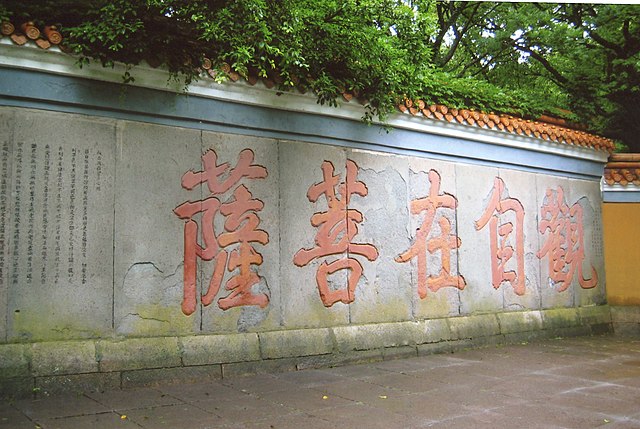
Martin Goodson
The Heart Sutra: The Swiss Army Knife of Mahayana Buddhism
One of the best known sutras, chanted throughout Asia and the Far East, has multiple uses and seems to evolve through time and place.

The Heart Sutra engraved on a wall in Mount Putuo, bodhimanda of Avalokiteśvara Bodhisattva
The Heart of Great Wisdom Sutra, often just known as the 'Heart Sutra' is used throughout Mahayana Buddhism for just about everything. It is chanted as a devotion to the Buddha's teaching on sunyata, or emptiness, it is used for protection, blessings, exorcism, gratitude & thanksgiving. It really is the Swiss army knife of sutras that can be turned towards anything.
Like the Lord's Prayer in Christianity, the Heart Sutra is known wherever there is Mahayana Buddhism, in Tibet, China SE Asia & Japan it is used in thanksgiving before meals, at the end of Zazen (sitting meditation), and in services of dedication.
Of course, the shortened version that is chanted is a concise distillation of the Prajnaparamita Sutra in 8,000 lines attributed to to Nagarjuna the founder of Madhyamaka or the 'Middle Way' school expounding the teaching of sunyata - emptiness of self-nature in all phenomena.
Given its ubiquity in truth there is little evidence that the shortened version goes back much before the 7th century C.E. It is not even certain if it was originally composed in Sanskrit, some assert that it was written in China.
Given that, there is most certainly a version in Sanskrit, the language of the Mahayana sutras.
Heart Sūtra in Sanskrit - Vidhya Rao (Eng sub)
The Great Bodhisattva Avalokitesvara, who is the Buddha's compassion personified, is speaking to Sariputra, foremost of the Buddha's earthly disciples. He sees into the emptiness of the Five Aggregates that make up the human being and sees that there are entirely empty of of any self-nature whatsoever.
So what does that mean?
Well, Nagarjuna was a philosopher which might mean that if we want to understand what he meant we should approach the subject thoughtfully...
Nagarjuna on Emptiness (History of Philosophy - India)
And yet... despite his clear erudition, it is clear that this is more than a thought experiment. For Nagarjuna 'emptiness' is to be realised ('experience' is transitory, whereas realisation is transformational).
Perhaps this is why the ritual chanting, even when we do not know much about what it is that we are chanting about, has a chance to cut through to something deeper.
The evocative heartbeat of the following example from Taiwan seems to re-create the physiological effects of the experience of 'awe' when we are confronted by the truly numinous.
Chanted by the Venerable Monks of Fu Yan Buddhist Seminary of Taiwan.
The fluidic nature of the teaching of emptiness is perhaps why the Heart Sutra is still open to re-interpretation without losing any of its essential power, as this musical version of the recitation from the Ikkyu-ji Temple in Kyoto conveys.
Heart Sutra (cho ver.)(2020 mix.) × Ikkyu-ji Temple,Kyoto,Japan
If you wish to learn to chant this sutra then you can find additional material on why we chant and how to chant in our own audio course on chanting which you will find here.




